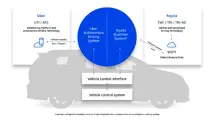Toyota's latest solar-powered Prius can charge when on the move
Toyota has fitted out an experimental Prius with a fresh rooftop solar kit to explore the limits of sun-powered road travel. Unlike the previous solar panels to adorn its plug-in hybrid, the new array will be capable of charging the vehicle while it is on the move, a feature that is hoped to give range and efficiency a significant boost.

Toyota has fitted out an experimental Prius with a fresh rooftop solar kit to explore the limits of sun-powered road travel. Unlike the previous solar panels to adorn its plug-in hybrid, the new array will be capable of charging the vehicle while it is on the move, a feature that is hoped to give range and efficiency a significant boost.
The World Solar Challenge is an endurance race across Australia for solar-powered vehicles, and each instalment shows us what is possible when cars are built for maximum efficiency. Entrants are hardly the kinds of cars you can load the family into and take off on a holiday, but some of the technologies they employ has been adapted to cars of a more traditional mold.
The ambitious and recently revealed Lightyear One EV is one, which is being developed by members of Solar Team Eindhoven who won the World Solar Challenges in 2013, 2015 and 2017. These guys reckon they can leverage five square meters (53.9 sq ft) of solar cells embedded in the roof and hood to power the car for up to 20,000 km (around 12,500 mi) of clean travel per year.
Toyota has also been exploring the potential of solar-powered cars for a little while now, first introducing a solar roof option for the production version of its Prius in 2012. The latest production iteration of this developed together with Panasonic generates 180 W and adds around 6.1 km (3.8 mi) of battery-only range per day, when left to charge up in ideal conditions.

By comparison, Toyota expects the latest array, which it has fitted to the roof, hood and rear hatch of a demo model Prius, to produce around 860 W. This jump comes courtesy of new and improved solar cells developed by Sharp with a conversion efficiency of 34 percent (compared to 22.5 percent of the production version), and can apparently add 44.5 km (27.6 mi) of battery-only range per day.
Whereas the production model will only charge the battery while parked and otherwise just feeds power into the car's onboard navigation systems and the like, the new demo version can charge the car while it is being driven, stretching that range out to 56.3 km (35 mi).
Toyota is set to start testing the new car this month on public roads in Japan, and will use the trials to gather data on the cruising range and fuel efficiency. It is collaborating with Sharp and Japan's New Energy and Industrial Technology Development Organization on the venture, with an eye to developing more advanced onboard solar recharging capabilities for its vehicles.



